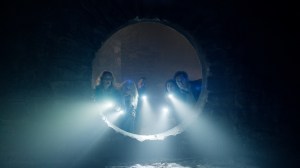For the first time in recorded history, astronomers may have discovered a free-floating black hole somewhere out amongst the cosmos. Researchers at the University of California, Berkeley published a study earlier month revealing their findings to the public. Led by Casey Lam and Jessica Lu, the team was able to observe the brightening of a distant star, noticing it was distorted by the gravitational pull of a nearby object, which they now believe to be a moving black hole.
Videos by ComicBook.com
“This is the first free-floating black hole or neutron star discovered with gravitational microlensing,” Lu said in a statement released by the university. “With microlensing, we’re able to probe these lonely, compact objects and weigh them. I think we have opened a new window onto these dark objects, which can’t be seen any other way.”
Lu hopes the team’s research will help other scientists further understand the birth of black holes, which may or may not be born once a star dies.
The team’s research first began in 2020 after analyzing five separate events captured by the Hubble Space Telescope, microlensing events they think may have been caused by stationary black holes.
“Casey and I saw the data and we got really interested. We said, ‘Wow, no black holes. That’s amazing,’ even though there should have been,” Lu said. “And so, we started looking at the data. If there were really no black holes in the data, then this wouldn’t match our model for how many black holes there should be in the Milky Way. Something would have to change in our understanding of black holes — either their number or how fast they move or their masses.”
“How long the brightening event lasts is a hint of how massive the foreground lens bending the light of the background star is,” Lam added. “Long events are more likely due to black holes. It’s not a guarantee, though, because the duration of the brightening episode not only depends on how massive the foreground lens is, but also on how fast the foreground lens and background star are moving relative to each other. However, by also getting measurements of the apparent position of the background star, we can confirm whether the foreground lens really is a black hole.”
The team’s study has been accepted for publication in The Astrophysical Journal Letters and includes analysis of other events beyond the recognition of what they believe to be the floating black hole.
All that said, Lu realizes a free-floating black hole would be a significant scientific development adding, “As much as we would like to say it is definitively a black hole, we must report all allowed solutions. This includes both lower mass black holes and possibly even a neutron star.”
Cover photo by Tobias Roetsch/Future Publishing via Getty Images








